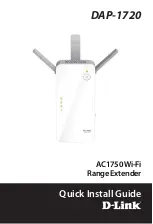
Wireless Access Point Model 0-1591700-x User Manual
Page 22 of 34
©2004 Tyco Electronics
Issue 3
Smart Channel
This uses the EN301 893 DFS (Dynamic Frequency Selection) mode to enable the access point to
“hop” to another channel if it encounters co-channel interference. When this option is enabled, the
client units will detect the presence of existing broadcasts in the spectrum and will hop to another
channel to avoid the working channel. The client will search for the new channel based on the
common SSID value. This “hop” can happen at any time and the mode is best used where there is
likely to be high levels of interference from access points and other sources. The default setting is
Off
. If Smart Channel is disabled, then DFS will only apply for the detection of radar activity.
Channel
This selects the required channel for the 802.11a band. Multiple access points in the network must
have the same SSID but can be assigned different channels to avoid interference if roaming is
required. The precise channels available are dependant on the country or region of usage. Consult
your local Radio Communications Agency for information. The relationship to frequency is:
Channel number = ((Radio frequency in MHz) - 5000MHz) /5
The default channel is
36
. The 802.11a band can support up to 8 non-overlapping channels in the
UK, US and parts of Europe. Therefore with up to 8 access points working together without co-
channel interference, the channel capacity is far higher than equivalent 802.11b/g networks that
only have 3 non-overlapping channels. For current channel assignments see page 4.
Advanced Settings
Radio On/Off
This mode is an enable/disable switch for the 802.11a band radio. With the switch set to Off the
radio is disable and will not respond to any signals. The default is
On
. Note that this radio must be
currently be turned off when the access point is used in Spain, Greece and certain other regions.
Check local regulations for latest information. See page 4 for details.
Data Rate
This control specifies the maximum transmit/receive data rate that the access point will process.
The available rates can be selected from a pull-down menu. The default setting is
Best
Transmit Power
This control is used to specify the maximum transmit power for the 802.11a band. The available
values are selected from a pull-down menu. The required power is difficult to assess without a
formal survey and so the default setting of
Full
is probably suitable. However, for regions where
the EN standards for Transmit Power Control (TPC) do not apply, it is probably best to use the
lowest possible power to avoid radio pollution and to improve overall security. The minimum
+available power is 10mW.
Beacon Interval
The access point transmits beacons periodically to declare the existence of the 802.11a network
and provide synchronisation infromation. Enter a value between 20 and 1000 to specify the
Beacon Interval. The default value is
100
. This will not need to be changed in normal networks.
DTIM Interval
This is the Delivery Traffic Indication Message (DTIM) and is a counter that informs clients of the
next available “window” for receiving certain classes of messages from the access point. The
default value is
1
and this should be suitable for most types of networks. Increase this value for
Power Save clients. If set to 100, data to known clients in the Power Save mode is buffered and
DTIM is sent once every 100 Beacon Intervals which will wake the client and indicate the presence
of waiting data.













































